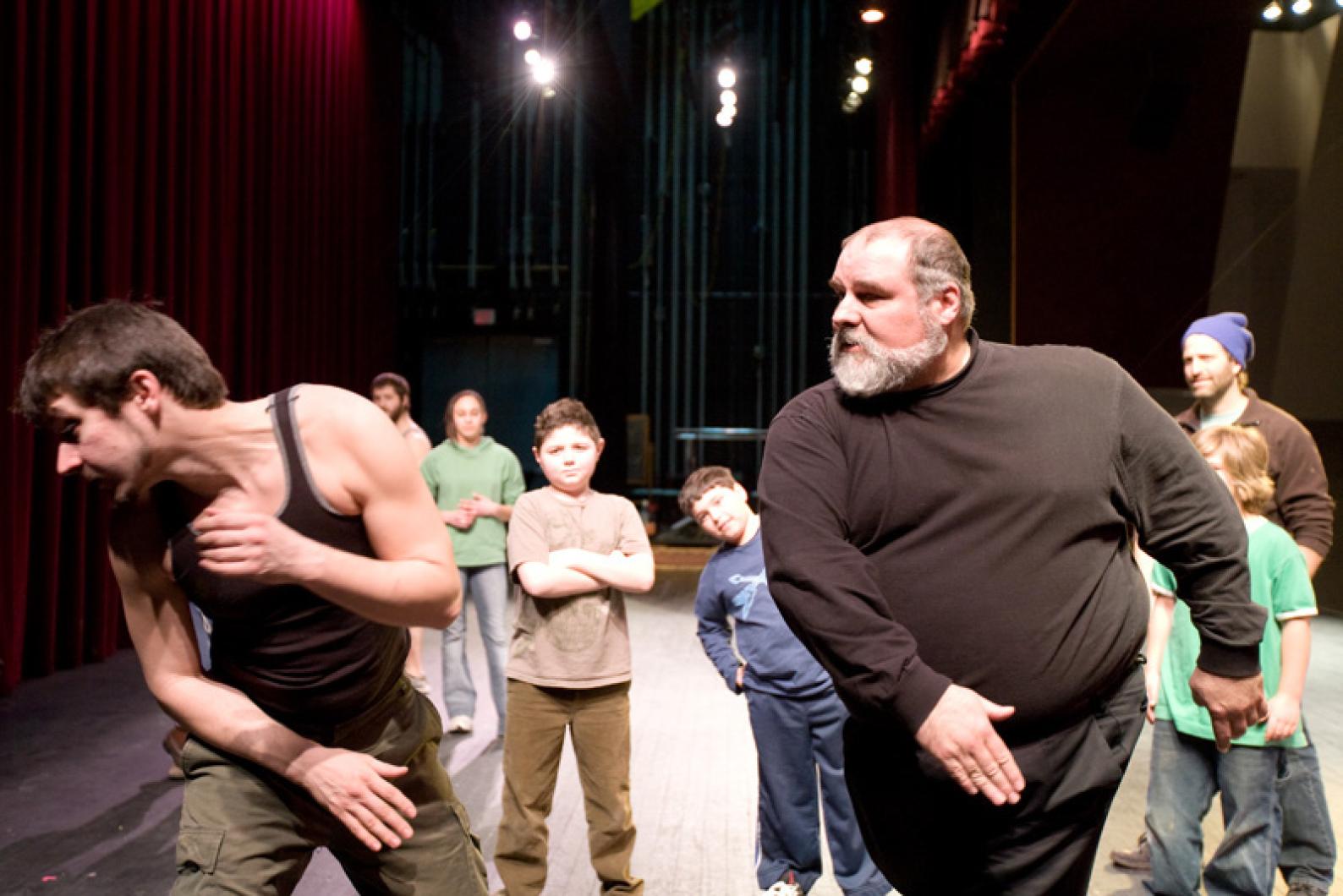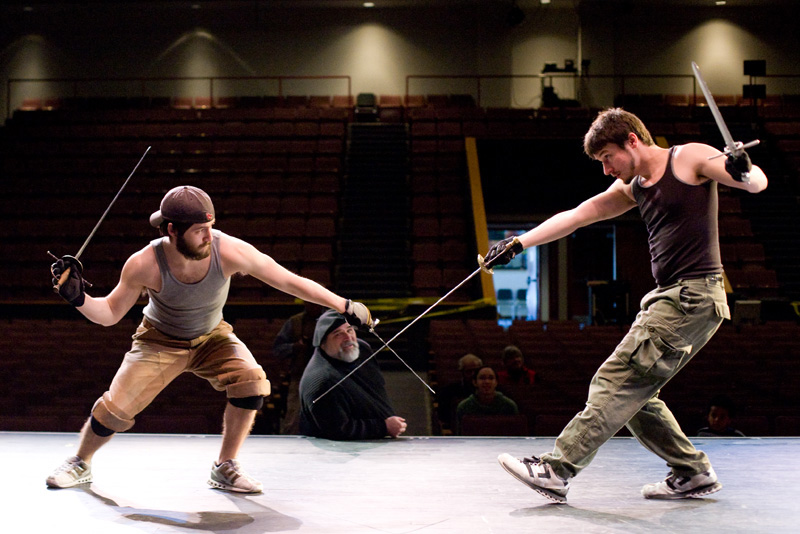The man in black, from his boots to bejewelled beret, was impeccably groomed on Tuesday as he stroked he neatly trimmed white beard and lamented how he’d been type-cast. He is usually the guy who gets beaten up — “the biker, the trucker, the redneck,” in his words. This experience in taking fake fisticuffs was what Broadway combat choreographer David Brimmer was passing on to an enthusiastic group of Vineyard students.
The fight master also shared the art of staged slaps, kicks and hair pulls, not to mention how to take an operatic knife to the heart.
“Show them a smash to the face, slash to the gut,” Mr. Brimmer asked two assistants, both his students from New York University’s Tisch School of the Arts. So Turner Smith and Edgartown native John Robichaud, sword-wielding swashbucklers in sneakers, smashed and slashed away on stage.
And not for the first time, Mr. Brimmer warned the younger students watching from the front rows of the regional high school arts center, “Do not try this at home.”
Fat chance. After some more impressive demonstrations — with accompanying history lessons on the relative merits of the cutlass versus the rapier versus the dagger — Mr. Brimmer brought the rapt youngsters on stage and paired them up for their own foam sword fights. And as the kids left the stage a couple of hours later, they were still practicing, all the way out to the parking lot.
“Can we touch that one?” asked six-year-old James Seccombe, pointing to the blade left on stage tantalizing close to his front-row seat.
No, not that one, said Mr. Brimmer, a regular sword-fighter himself on stage at the Metropolitan Opera. Why not? Well, he explained, that’s a cutlass. And your cutlass is for killing in small spaces. Ship decks, specifically. So these short sharp blades were often wielded by sailors and pirates around the 15th century.
Rapiers, he explained, could be as long as five feet, and so they were favored by the merchant class — gentlemen who might have to go, possibly packing gold in their pockets, down to the wharves where the sailors and pirates were working, cutlasses at their sides. A merchant’s long rapier could reach the skin of an aggressive seaman at a safe distance. Still, these gentlemen carried daggers too, in case they found themselves in too close to use the rapier, Mr. Brimmer said, interrupted by a slash.
The sound of the rapier cut the air like a whip. This time, Mr. Smith and Mr. Robichaud were performing their fight scene at speed, adding their own sound effects, panting from effort and crying out in (fake) pain, to the demonstration.
“Duelling was not very genteel,” Mr. Brimmer added, though he hardly needed to. “Both duellers would usually die,” he added, as the young men in cargo pants were limping, then writhing, still stabbing, to the death behind him.
Mr. Brimmer currently has three Broadway shows featuring his fight choreography running on Broadway and several off Broadway shows. He explained to the Island youngsters attending this free workshop sponsored by The Yard that the key to making a fight scene work is communicating with your partner.
He brought them all up on stage, put them in a circle, and got them to “throw” imaginary artillery at each other — Shay Sullivan, a fourth grader at the charter school, threw what might have been a medicine ball at Bizu Horwitz, a six-year-old from the Tisbury School, who doubled over in fake pain before shooting an arrow at young Ben Tillman across the circle. High schooler Sarah Swift buckled as a gunshot hit her in the shoulder, before throwing a punch to nine-year-old Ciara Seccombe, who was decidedly more gentle with her charter school classmate Sydney Jasny.
“Look at them playing the wound!” boomed Mr. Brimmer, amused as his dramatically injured charges fell to the floor from missiles only they could see.
Next the kids learned the art of a nasty slap. “Show your hand on this side of the face you’re going to slap,” Mr. Brimmer explained, “then on the other side . . . let the audience watch your hand and focus on the victim’s moving head, reacting.” No one will notice the victim slyly clap out the sound of the slap if they all are watching him wince. Clap, clap, clap popped the hidden hands of those supposedly being slapped, all clearly delighted to be “playing the wound.”
The punch was the same idea, just more challenging.
Choking? With that, the choker’s hands are actually pushing away from the neck while the actor playing the victim pulls his perpetrator’s hands in as close as he is comfortable ... all the audience sees in the tension of the hands struggling against each other. Hair pulling is a similar trick.
“In the theatre we want to show the truth of the violence, not the reality,” Mr. Brimmer said, adding that a lot of special-effects driven violence in films showed people miraculously surviving impossible blows. “On stage, ever since Shakespeare — who knew that fights sold tickets — playwrights have been trying to show the truth of violence, and that is this: there are consequences.”








Comments
Comment policy »